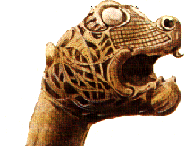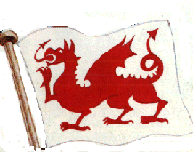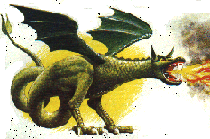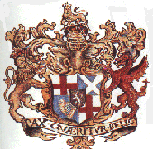






dragons
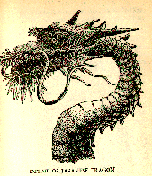
Japanese dragon |

pictures used hopefully with out the objection of their creators |
moreta |
This page(s) will no doubt take a long time to complete and probably be missing what some people think are the most obvious of dragons. When first planning some pages on fantasy & mythological creatures I wasn't sure whether to include just the dragons of myth or to go the whole hog and cover fiction as well. I came to the conclusion though that when dragons are mentioned people not only think of the likes of "George & the dragon" but also dragons such as SMAUG from Tolkein and The Dragon weyrs of Mccaffey's Pern. It seems that the list in fiction is endless so I will start with the Dragons of legend and hopefully get round eventually to covering those of fiction.
![]()
|
|
||||
|
|
||||
|
|
|
|||
|
|
|
|||
|
|
|
|||
|
|
|
|||
|
|
||||
|
|
|
|||
|
|
||||
|
|
|
|
These dragons generally were seen as evil. Noted for their ability to fly, resist magic and breath fire. Associated unlike the dragons of the east with vast piles of treasure & gold. They came in many sizes & colors but were often described as shining in the sun. the dragon would usually be huge with a scaly body serpent like in shape with massive claws and wings set vertically across its body, unlike a birds which are horizontal. With its ability to breath fire it was a fearsome sight flying the land in search of prey and gold. |
It was said that a dragon was cold blooded and could only sleep on gold so as to keep its body cool when not active. Tales of dragons carrying off cattle in its claws are common, as are sacrifices of virgin maidens to them. Gold not taken by the dragon itself would be given by local folk to appease it and hopefully encourage it to hunt elsewhere.
|
|
Often the dragon has been used as a symbol of war. Notably the carved heads of the Vikings Dragon ships or long ships. In England long before the Norman invasion in 1066 Dragons were the most popular symbols of war. The name "Pendragon" was often given to a knight who had killed a chief in battle or done some other heroic deed. |
|
|
King Arthur's father bore the name Uthor Pendragon and carried a shield and battle banner depicting a golden dragon. In 1066 as shown on the Bayeux Tapestry the ships of William, Duke of Normandy also carried the heads of Dragons carved on their sterns. |
In the sixteenth century when muskets were new it seemed as if they were spurting fire and it was likened to dragons breath. After this they were often seen with the muzzle carved in the shape of a dragon head or mouth. This was also carried over to early cannons. These early musketeers when mounted soon became known as "dragoons".
The Babylonian dragon queen..see TIAMAT on the MEDITERRANEANpage.
|
|
The western dragon lore is also prolific in heraldry, seen in many guises on shields, banners, armor, coats of arms and flags. Wales has a red dragon on its flag, England the white dragon of Saint George. Many examples can be found throughout Europe. |
In the fifth century, after the arrival of the Roman's, King Vortigern was said to have fled with 12 men to the foot of Mount Snowdon in Wales. Taking refuge there he quickly saw the advantages of the wild land and ordered a great fortress to be built for him at a place called Dinas Emrys. Long through the day would the workmen toil on the foundations yet inexplicably at night the ground would swallow up their work. By day the work would restart for it all to be undone again at night. Convinced that the land must be cursed that the work slowed and then halted. Consulting his wise men the King was told that this curse could only be broken by sprinkling the blood of a fatherless boy on the sight first. So the search went out and in Camarthen such a boy was found , the 7 year old boy was called Merlin.
Merlin was bought before the King for sacrificing, but before the deed could be carried out Merlin revealed that he had a gift for seeing into the future, and offered an explanation as to what was really happening under the new castles foundations. Merlin explained that deep underneath the site was a cavern with a pool in which two Dragons lived. One was red and the other white and every night they fought so fiercely that they cracked the ground open.
The King ordered his men to dig until they found the cavern and the two sleeping Dragons, which once awake again continued their fight. Merlin explained that the two Dragons represented the two British nations, the red one Celtic and the white Saxon. He foretold hundreds of years of fighting between the two but that in time the red would come to represent the Welsh nation. Prudently the King decided to leave the Dragons alone and moved his fortress to South Wales, as to Merlin the King spared his life and he grew to be the Magician and wizard known world wide.
|
|
Welsh Dragons like many western Dragons are said to be very rich, even wearing gems and gold rings in their tails. others would demand gifts of small children for breakfast. devouring a whole sheep in one meal was common. Welsh Dragons were usually found at the bottom of lakes or guarding holy places such as shrines or wells. As with most Celtic/Saxon influenced countries there are many legends relating to the Dragons, Saint George is said to have killed at least one Dragon in Wales. |
The town of Denbigh is said to have got its name after a noble man(some say St. George) had slain a Dragon that had been threatening the area. When the Dragons head was carried through the town after its death the towns people greeted the "dragon-slayer" with shouts of "Dim bych Dim bych" which meant "no more Dragon", Denbigh still retains that name today. In modern Wales Dragons can still be found on churches, heraldic shields,weather vanes, shops and public buildings. It is still customary to fly a red Dragon banner or flag on public buildings in Wales with the motto y Ddraig Goch Ddyry Chchwyn -THE RED DRAGON TAKES THE LEAD.
One tale from Wales is from Llandeilo Graben 5 miles south east of Builth Wells of a Dragon that slept on the church tower at night. By day it would terrorize the area as is the norm for Dragons until a local plough boy managed to kill it. He came up with the idea of making a dummy man which he dressed and fixed on the tower. So enraged was the dragon that it immediately attacked, unfortunately for the Dragon it hadn't noticed that the dummy was covered in sharp spikes and wounded itself so badly that it bled to death.
Greek mythology has many tales of dragons, Apollo the son of Zeus was said at the age of four to have slain the Dragon "python" using a bow and arrow. This was to prove that he was a worth son to the greatest of the Greek gods. Zeus himself was said to have overcome the great Dragon Typhon using a thunderbolt before imprisoning him under Mount Etna. This is why we are told that the volcano is so active as the Dragon is constantly trying to escape its bonds. The Greek epic of Jason & the Argonauts and their quest for the golden fleece tells how the fleece was guarded by a fierce Dragon. The Dragon during the fight had managed to get Jason into its mouth and it was only the intervention of the goddess Athena that caused the Dragon to spit out Jason and allow them to take away the prized golden fleece.
|
|
As in so many cultures the Norse men & Vikings had their tales of Dragons. As a symbol of strength and war they could be found on the long ships that terrorized so much of Europe and to places as far afield as Africa. Nordic mythology tells of many strange creatures but the Dragon is the most prominent. Shown here is a design found on an ancient Scandinavian door depicting the fight between Sigurd and the Dragon Fafnir. After killing the Dragon , Sigurd roasted the heart over a fire. After tasting the blood & heart of the Dragon he was instantly able to understand the language of birds. |
FIRE-DRAGONsee N EUROPE page FIRE DRAGON
George and the Dragon has many different versions and its origins go back so far in time that they have become blurred. Which George, which dragon, what place & location of the battle have now become so varied that I will give the most common variant. Brought to England from the middle east by returning crusaders the story spread like wildfire and has been celebrated since 1222 when it was decreed that a national festival should be held annually on 23rd April to honor the now patron saint.
|
|
George was not English but an eastern "saint"& latter adopted. He was born in Asia Minor and as a young man traveled the land in the days when Christianity wasn't widespread. His travels took him to the town of Silene which was in the region of Libya north Africa. Outside the town was a lake where lived an evil dragon, which at night would climb the walls of the town and kill people with its poisonous breath and then devour them. |
As the dragon rose up through the murky waters of the lake George closed his helmet to prevent the poisonous breath reaching him and readied his lance. Just as the head broke the waters surface he launched his attack, plunging the lance deep into the body of the dragon. Lashing its tail in a mad frenzy George told the princess to take of her jeweled belt and to tie the dragon while he held pinned it with his lance. Terrified she did so and amazingly the dragon immediately quietened and became gentle. George and the princess then rode victoriously back to Silene with the dragon following tamely behind them. The town's people flew into panic & terror at the sight of the strange threesome so George taking his sword struck of the head of the dragon. It was said that the whole town of Silene converted to Christianity in honor of "saint George".
By the time of the middle ages takes of Dragons were common and a knight was nobody until he had at least fought a Dragon. One of the earliest British Dragon tales is the LAIDLY WORM of LAMBTON, in the north east of England.
|
|
As a boy the heir of LAMBTON would spend his Sundays fishing in the river Wear,something frowned on on the sabbath. One day he found on his hook a tiny worm, to small for bait he threw it in the river and never thought on the worm anymore. Amazingly in no time at all this worm grew until it was the size of an enormous Dragon. It would lie every day in the sun on the banks of the river Wear,coiled around a rock or itself nine times. |
Adeep pool just north of the church was said to be the haunt of a Dragon that would and feed on cattle and sheep, it was also no averse to the taste of men if needs be. For many years the Dragon terrorized the area until a Knight eventually slew the beast and received in reward the hand of the Sussex kings daughter. The Knights tombstone can still be seen in the church. Sussex being one of the last counties to be christianized has may pagan and Dragon tales and this particular one has quite a few variations in the telling.
Ben Vair in Scotland is where tourist to Glencoe Argyll are landed,it takes its name from the Dragon that used to live in a great hollow in the face of a mountain known as Corrie Lia. Of traditional appearance this Dragon would peer over the path that rose from the foot of the mountain, from this lair it would leap down and attack unwary travelers. The Dragon was a female and said to be so terrifying that no one dared to tackle it until a man known as "Charles the Skipper" arrived in Ben Vair.
|
|
Charles devised a plan to tackle the Dragon by anchoring his boat some way from the shore and building a pontoon bridge. Using empty wooden barrels between the boat and the shore he lashed them together with ropes and added his final touch, long iron spikes the length of the "bridge". To all that viewed it it was a floating porcupine of wood and iron. |
MODERN DRAGONS IN USES TODAY...
|
|
Today in the 21st century Dragons can still be found in popular usage. As mentioned earlier it can be found on flags around the world, and especially in the heritage of Wales. In London the coat of arms of Greys Inn, one of the four Inns of court to which lawyers belong depicts a Dragon rampant. The reason for this was to encourage fear and respect for the law of the land. |
|
|
In medieval times the Dragon had been adopted as a heraldic symbol and decoration and as was then is also the case now that anyone wishing to can use a Dragon as part of their coat of arms, provided that it is approved by the Royal College of heralds. Shown here was the coat of arms for Oliver Cromwell (1599-1658) who also used a Dragon . It was shown rampant(forelegs raised) wings endorsed( held above the back) and with a nowed (knotted) tail. In heraldry the Dragon represented strength, invincibility and fierceness. |
|
|
Early in the 19th century the Prince Regent had built in Brighton Sussex the Royal Pavilion. This building was based on Indian and Oriental designs. In one of the rooms, the banqueting room can be found a metre-long carved Dragon (shown) that has recently been restored to its full glory and hanging from its tail is a magnificent chandelier. |
|
|
Many people looking at this section will no doubt wonder at my inclusion here of a person, so I will explain. The ISP that I usually connect with is Lineone, and as a regular user of their chat rooms I have gotten to know many people over the past year or two. This lady as the title suggests goes by the nickname of Dragonese. Having chatted to her for over two years and met her at various gathering organized throughout the Lineone members I felt that she should be included here. She is the friendliest and most helpful "Dragon" that I have had the pleasure to meet. |
| So take a bow"Dragonese". |
Dragons of the east, unlike their western counterparts usually represent good. They are generally regarded as the rulers and controllers of the elements. The great chinese dictionary pan tsao muwritten around AD 1600 had this to say of them :-
|
|
The dragon is the largest of the scaled creatures. Its head is like a camel's,its ears like a bull's, its neck like a snake, its belly like a frog, its scales like a carp, its claws like an eagles and a paw like a tiger. |
|
|
There are several different kinds of dragons responsible for the running of the world. The Celestial Dragon(T'ien lung) protected the heavens and was guardian of the gods heavenly goods and carried on his back the palaces of the gods that might otherwise fall onto the earths cities and destroy them. |
|
|
The Devine Dragon(shen lung) a spiritual five toed dragon made the wind and the rains and was the bringer of storms. Shen lung was also the Imperial Dragon and only the Emperor of China or his servants were alowed to wear his image, the penalty for anyone else to do so was death.The Terrestrial Dragon looks after streams and rivers and decides which way they should flow,and the Subterranean Dragon(Fu-ts'ang) guards the treasures that are forbidden to man. |
The sea Dragon Kings live in lavish underwater palaces and feed on opals and pearls. Its said that there are five of these kings.The chief who lives in the middle,and four others who live at the four points of the compass. Each Dragon is 5 or 6 kilometres long, and said to topple whole mountains if the turn at night. They have large whiskery snouts, yellow scales,shaggy legs and tails and wild flaming eyes. Thier mouths hang constantly open showing thier long tongue's & sharp teeth. if they breath to heavily they can cook whole shoals of fish. When these Dragons come to the surface they are the cause of whirlpools, typhoons and whirlwinds. If they take to the skies in flight they cause huge hurricanes. Despite these Dragon caused disasters they are regarded as fatherly and kind and also known for thier vanity.
|
|
During important celebrations & festivals in china a paper dragon is carried through the streets in a prossesion. a man must run before the dragon carrying a large red or white ball, this represents the pearl which the dragon is said to always be vainly chasing. |
The Chinese still believe that the Dragons look after them very well,and usualy that things run very smoothly. When there is a flood or drought it is thought that the dragon kings must be angry with them.If there is flood, jewels and prayers written on paper are thrown into the waters hopeing to make peace with the angry Dragon. If there is drought a paper dragon is made and carried through the streets. It calls at every house , and everyone that answers the door sprinkle it with water. A water carrier also runs alongside the dragon sprinkling the ground and shouting "here comes the rain".
One of the legends form China concerning Dragons is that of the Dragon Mother, it has quite a few variations but follows in general as such:-
|
|
Long ago when the world was much younger, an old lady was walking beside a river. There before her, lying in the grass on the river bank she saw five coloured stones. So beautiful were they that she picked them up and carried them away to her home where she would offen look at them and marvel at thier beauty. Time passed until one day there was a terrible storm and amd the thunder & rain the stones hatched for they were in fact Dragon's eggs. |
Eastern Dragons metamorphosed ,changing as a caterpillar changes to a butterfly,but taking a somewhat longer period of time than a caterpillar to reach full maturity. this process usualy took 4000 years to complete. A mature Dragon would lay its eggs near water, for even though many lived on land thier ancestors were all water creatures.From being layed the egg would take 1000 before it was ready to hatch,the eggs looking like colourful stones.When hatched the Dragon would resemble a water snake and would then take a further 500 years to grow what looked like the head of a carp and was known as Kiao, not dissimilar in name to the prized fish of the Chinese the Koi which is a member of the carp family. Another 1000 years would pass in the reaching of its next stage which would have the Dragon having a fish like body covered in hard scales and four legs with usualy four claws on each foot, an elongated tail and a bearded face. this stage was called Kiao-lung (lung meaning deaf) Over the next 500 years the Dragon would grow horns through which it would be able to hear, this stage was known as Kioh-lung. So the metamorphosis continued on, in the next 1000 years the Dragon would grow wings , this final stage was known as Ying-lung or winged Dragon and would finaly bring the Dragon to full maturity so as to start the process over again.
|
|
Many cultures around the world saw the Dragon as part of an eternal cycle and can often be seen in pictures biting on its tail.This symbolism was to represent the circle of life and in Europe was offen used as a sign for medieval alchemists over thier doors. |
|
|
In Koyoto Japan there is the legend of O-gon-cho, a great white Dragon that lived in the middle of the lake there. Every 50 years the Dragon would change its appearance and become a magnificent songbird with golden feathers. But people came to fear the bird and didnt want to hear its song, localy it had become known as the Songbird of Sadness. The reason for this was , like the mournfull howl on a moonlight night the birds song always seemd to fortell disaster. Disease or famine , sometimes both would follow its appearance. It was claimed that O-gon-cho was sighted in April 1834 and sure enough, soon afterwards there was widespread famine in the region and many people died of starvation and disease. |

Material Copyright © 2000 f. parker
